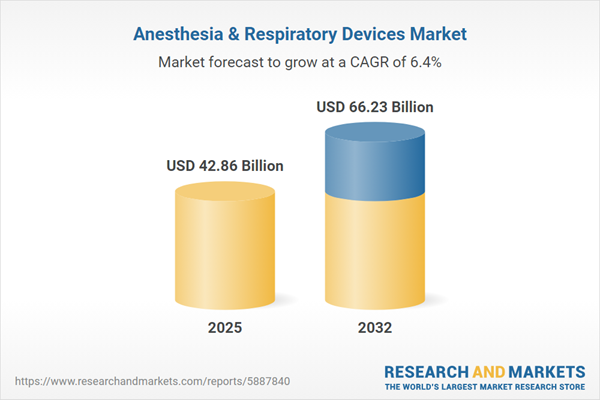Speak directly to the analyst to clarify any post sales queries you may have.
Senior executives navigating the anesthesia and respiratory devices market must stay ahead of evolving technologies, care models, and regulatory landscapes. Comprehensive intelligence on segmentation, competition, and emerging trends is essential for informed strategic decisions amid rapid industry transformation.
Market Snapshot: Anesthesia & Respiratory Devices
The global anesthesia and respiratory devices market continues to demonstrate resilient expansion, rising from USD 40.27 billion in 2024 to USD 42.86 billion in 2025, with a projected CAGR of 6.41%. The market is set to reach USD 66.23 billion by 2032, underscoring strong momentum fueled by innovation, demographic shifts, and growing clinical needs. This trajectory highlights investors’ ongoing confidence in device adoption and expansion across hospitals, ambulatory centers, and home care settings. Regional growth is marked by diverse drivers, from reimbursement reforms to infrastructure modernization in high-growth economies. As healthcare delivery adapts, demand for portable, connected, and patient-centric devices continues to intensify.
Scope & Segmentation: Advancing Market Understanding
- Product Categories: Anesthesia machines, CPAP devices, nebulizers (jet, mesh, ultrasonic), oxygen concentrators, invasive and noninvasive ventilators including advanced modes like pressure control and hybrid mode.
- Applications: Emergency, transport, home care, intensive care (neonatal, pediatric, adult), and operating rooms.
- End Users: Hospitals, clinics, home care environments, and ambulatory surgical centers.
- Technologies: Invasive, noninvasive, and hybrid devices tailored to varied clinical needs and patient groups.
- Patient Demographics: Adult, neonatal, pediatric, and standard age groups.
- Mobility Options: Portable and stationary models across core device categories.
- Distribution Channels: Direct sales, distributors, and online platforms serving end users globally.
- Power Sources: Battery, electric, pneumatic, and manual systems, key for operational versatility.
- Operational Modes: Hybrid, volume control, pressure control, spontaneous mode to match clinical requirements.
- Pricing Tiers: Economy, standard, and premium positioning reflecting technology and service integration.
- Regional Coverage: Americas (North and Latin America), Europe Middle East & Africa, Asia-Pacific—including targeted breakouts for growth markets and mature economies.
- Leading Companies: Analysis features GE HealthCare Technologies, Koninklijke Philips, Drägerwerk, Medtronic, Fisher & Paykel Healthcare, Hamilton Medical, Smiths Group, Teleflex, B. Braun Melsungen, ResMed.
Key Takeaways for Decision-Makers
- Technological convergence is rapidly advancing, driving integrated device ecosystems that combine digital monitoring and data-driven analytics to improve patient outcomes and care efficiency.
- Demand for home-based and portable solutions is rising across regions, highlighting the importance of adaptability in both design and supply chains.
- Regulatory expectations around interoperability and cybersecurity are shaping both product development and market access, compelling stronger collaboration with software vendors.
- Comprehensive segmentation shows varied procurement patterns across end users and regions, with some markets prioritizing affordability while others seek advanced AI-enabled functionality.
- Value-based reimbursement and outcome-driven metrics are influencing purchasing behavior, reinforcing the need for patient-centric features and service innovation.
Tariff Impact: Navigating the 2025 Regulatory Shift
The 2025 U.S. tariff changes are reshaping supply chains and pricing structures for device manufacturers. New duties on critical inputs—such as precision sensors and medical-grade polymers—are prompting firms to diversify sourcing and accelerate the adoption of cost-efficient manufacturing technologies. This has intensified competition and led to renewed focus on lean operations, as well as agile responses to shifting regional trade environments and fluctuating input costs.
Methodology & Data Sources
This analysis employs a multi-phased research model: primary interviews with manufacturers and clinical leaders, in-depth literature and regulatory reviews, rigorous data triangulation, and scenario modeling. Validation from subject matter experts ensures actionable, evidence-based recommendations tailored for senior decision-makers.
Why This Report Matters
- Offers a clear roadmap for aligning product portfolios with fast-shifting clinical and market requirements.
- Enables supply chain and procurement leaders to anticipate tariff impacts and regional risk factors.
- Supports technology investment and partnership strategies—essential for capturing growth and maintaining competitive advantage.
Conclusion
This in-depth report equips executives with the strategic context and actionable insights needed to lead confidently in the evolving anesthesia and respiratory devices sector. Leverage the findings to optimize innovation, operational resilience, and long-term growth.
Additional Product Information:
- Purchase of this report includes 1 year online access with quarterly updates.
- This report can be updated on request. Please contact our Customer Experience team using the Ask a Question widget on our website.
Table of Contents
3. Executive Summary
4. Market Overview
7. Cumulative Impact of Artificial Intelligence 2025
Companies Mentioned
The companies profiled in this Anesthesia & Respiratory Devices market report include:- GE HealthCare Technologies Inc.
- Koninklijke Philips N.V.
- Drägerwerk AG & Co. KGaA
- Medtronic plc
- Fisher & Paykel Healthcare Corporation Limited
- Hamilton Medical AG
- Smiths Group plc
- Teleflex Incorporated
- B. Braun Melsungen AG
- ResMed Inc.
Table Information
| Report Attribute | Details |
|---|---|
| No. of Pages | 181 |
| Published | October 2025 |
| Forecast Period | 2025 - 2032 |
| Estimated Market Value ( USD | $ 42.86 Billion |
| Forecasted Market Value ( USD | $ 66.23 Billion |
| Compound Annual Growth Rate | 6.4% |
| Regions Covered | Global |
| No. of Companies Mentioned | 11 |









